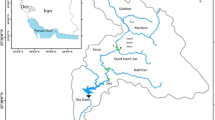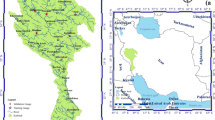Abstract
This study employs Bayesian multiple regression analysis using the ordinary least squares method for regional low flow frequency analysis. The parameter estimates using the Bayesian multiple regression analysis were compared to conventional analysis using the t-distribution. In these comparisons, the mean values from the t-distribution and the Bayesian analysis at each return period are not significantly different. However, the difference between upper and lower limits is remarkably reduced using the Bayesian multiple regression. Therefore, from the point of view of uncertainty analysis, Bayesian multiple regression analysis is more attractive than the conventional method based on a t-distribution because the low flow sample size at the site of interest is typically insufficient to perform low flow frequency analysis. Also, we performed low flow prediction, including confidence intervals, at two ungauged catchments using the developed Bayesian multiple regression model. The Bayesian prediction proves effective to infer the low flow characteristic at the ungauged catchments.
Similar content being viewed by others
References
Ashkar, F. and Ouarda, T. B. M. J. (1998). “Approximate confidence intervals for quantiles of gamma and generalized gamma distributions.” Journal of Hydrologic Engineering, ASCE, Vol. 3, No. 1, pp. 43–51.
Chowdhury, J. U. and Stedinger, J. R. (1991). “Confidence interval for design flood with estimated skew coefficient.” Journal of Hydraulic Engineering, ASCE., Vol. 117, No. 7, pp. 811–931.
Cohn, T. A., Lane, W. L., and Stedinger, J. R. (2001). “Confidence intervals for expected moments algorithm flood quantile estimates.” Water Resources Research, Vol. 37, No, 6, pp. 1695–1706.
Coles, S. G. and Powell, E. A. (1996). “Bayesian methods in extreme value modeling: A review and new developments.” International Statistical Review, Vol. 64, No. 1, pp. 119–136.
Durrans, S. R. and Tomic, S. (1996). “Regionalization of low-flow frequency estimates: An Alabama case study.” Water Resources Bulletin, Vol. 32, No. 1, pp. 23–37.
Fill, H. D. and Stedinger, J. R. (1998). “Using regional regression within index flood procedures and an empirical Bayes estimator.” Journal of Hydrology, Vol. 210, pp. 128–145.
Kavetski, D., Kuczera, G., and Fanks, S. W. (2006). “Bayesian analysis of input uncertainty in hydrological modeling: 1. Theory.” Water Resources Research Vol. 42, W03407.
Kelly, K. S. and Krzysztofowicz, R. (1994). “Probability distributions for flood warning systems.” Water Resources Research, Vol. 30, No. 4, pp. 1145–1152.
Kingston, G. B., Lambert, M. F., and Maier, H. R. (2005). “Bayesian training of artificial neural networks used for water resources modeling.” Water Resources Research, Vol. 41, W12409.
Krzysztofowicz, R. (1983a). “Why should forecaster and a decision maker use Bayes theorem.” Water Resources Research, Vol. 19, No. 2, pp. 327–336.
Krzysztofowicz, R. (1983b). “A Bayesian Markov model of the flood forecast process.” Water Resources Research, Vol. 19, No. 6, pp. 1455–1465.
Kuczera, G. (1999). “Comprehensive at-site flood frequency analysis using Monte Carlo Bayesian inference.” Water Resources Research, Vol. 35, No. 5, pp. 1551–1557.
Kuczera, G. and Parent, E. (1998). “Monte Carlo assessment of parameter uncertainty in conceptual catchment models: The Metropolis algorithm.” Journal of Hydrology, Vol. 211, pp. 69–85.
Leavesley, G. H., Lichty, R. W., Troutman, B. M., and Saindon, L. G. (1983). Precipitation-runoff modeling system: User’s manual, Water-Resources Investigations Report 83-4238, USGS, Washington DC.
Lee, K. S. and Kim, S. U. (2008). “Identification of uncertainty in low flow frequency analysis using Bayesian MCMC method.” Hydrological Processes, Vol. 22, pp. 1949–1964.
Madsen, H. and Rojsberg, H. D. (1997). “Generalized least squares and empirical Bayes estimation in regional partial duration series index flood modeling.” Water Resources Research, Vol. 33, No. 4, pp. 771–781.
MOCT and K-Water (2006). River basin investigation for the future, Kyeonggi-Do, Republic of Korea (In Korean).
O’Connell, D. R. H., Ostenaa, D. A., Levish, D. R., and Klinger, R. E. (2002). “Bayesian flood frequency analysis with paleohydrologic bound data.” Water Resources Research, Vol. 38, No. 5, pp. 1–14.
Parent, E. P. and Bernier, J. (2003). “Bayesian POT modeling for historical data.” Journal of Hydrology, Vol. 274, pp. 95–108.
Reis, Jr. D. S. and Stedinger, J. R. (2005). “Bayesian MCMC flood frequency analysis with historical information.” Journal of Hydrology, Vol. 313, pp. 97–116.
Reis, Jr. D. S., Stedinger, J. R., and Martins, E. S. (2005). “Bayesian generalized least squares regression with application to log Pearson type III regional skew estimation.” Water Resources Research, Vol. 41, W10419.
Seidou, O., Ouarda, T. B. M. J., Barbet, M., Bruneau, P., and Bobee, B. (2006). “A parametric Bayesian combination of local and regional information in flood frequency analysis.” Water Resources Research, Vol. 42, W11408.
Sorensen, D. and Gianola, D. (2002). Likelihood, Bayesian, and MCMC methods in quantitative genetics, Springer-Verlag, New York.
Stedinger, J. R. (1983). “Confidence intervals for design events.” Journal of Hydraulic Engineering, ASCE, Vol. 109, No. 1, pp. 13–27.
Stedinger, J. R., Vogel, R. M., and Foufoula-Georgiou, E. (1993). Frequency analysis of extreme events, In: Maidment D (Ed.) Handbook of Hydrology, McGraw-Hill, New York, Chapter 18.
The MathWorks (1993). Statistics tool box user’s guide version 5, The MathWorks Inc., MA, USA.
Thiemann, M., Trosset, M., Gupta, H. V., and Sorooshian, S. (2001). “Bayesian recursive parameter estimation for hydrologic models.” Water Resources Research, Vol. 37, No. 10, pp. 2521–2535.
Vicens, G. J., Rodriguez-Iturbe, I. and Schaake, Jr. J. C. (1975). “A Bayesian framework for the use of regional information in hydrology.” Water Resources Research. Vol. 11, No. 3, pp. 405–414.
Vrugt, J. A., Gupta, H. V., Bouten, W., and Sorooshian, S. (2003). “Shuffled complex evolution Metropolis algorithm for optimization and uncertainty assessment of hydrologic model parameters.” Water Resources Research, Vol. 39, No. 8, SWC 1–16.
Wang, Q. J. (2001). “A Bayesian joint probability approach for flood record augmentation.” Water Resources Research, Vol. 37, No. 6, pp. 1707–1712.
Whitley, R. J. and Hromadka, II. T. V. (1999). “Approximate confidence intervals for design floods for a single site using a neural network.” Water Resources Research, Vol. 35, No. 1, pp. 203–209.
Wood, E. F. and Rodriguez-Iturbe, I. (1975a). “Bayesian inference and decision making for extreme hydrologic events.” Water Resources Research, Vol. 11, No. 4, pp. 533–542.
Wood, E. F. and Rodriguez-Iturbe, I. (1975b). “A Bayesian approach to analyze uncertainty among flood frequency models.” Water Resources Research, Vol. 11, No. 6, pp. 839–843.
Zhang, B. and Govindaraju, R. S. (2000). “Prediction of watershed runoff using Bayesian concepts and modular neural networks.” Water Resources Research, Vol. 36, No. 3, pp. 753–762.
Author information
Authors and Affiliations
Corresponding author
Rights and permissions
About this article
Cite this article
Kim, S.U., Lee, K.S. Regional low flow frequency analysis using Bayesian regression and prediction at ungauged catchment in Korea. KSCE J Civ Eng 14, 87–98 (2010). https://doi.org/10.1007/s12205-010-0087-7
Received:
Accepted:
Published:
Issue Date:
DOI: https://doi.org/10.1007/s12205-010-0087-7




